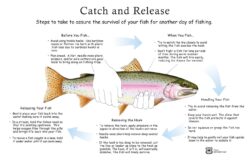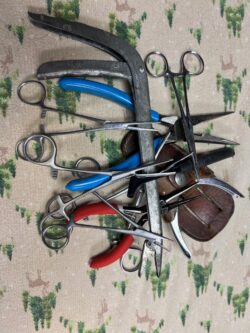Catch and Release fishing is extremely important to conserve Wild and Native trout fisheries. A great and healthy trout may survive 4-6 hook ups. After that they will die.
Great guides and mentors are excellent at teaching how to handle and release fish. They can remove hooks delicately and not distress the trout more than needed. Watch them and learn.
Novice anglers are so excited to catch the fish, they often take selfies and cellphone pictures like crazy. The additional time and stress are not healthy for the trout. When they take the perfect picture, the fish becomes squeezed, dropped, and often injured. Kissing the fish surely does not help either. All of this takes time. When the fish is first hooked, the clock is running. Experienced anglers can catch and release, and even take a picture in less than 5 minutes.
Trout most commonly die from several injuries. If they bleed from the gills, squeezed too tight, ruptured air bladder, Fungus infection from loss of scales/protective mucous on skin, being blinded, stress from being out of the water too long, stress from being played too long, not be revived after a battle, temperature shock, and more. None of these involve raptors, other predators, pelicans, and fish-eating critters. They usually clean up the dead fish.
Even if an experienced angler or guide handles and releases the trout properly, studies say there is a 10% mortality. We have released fish that swam away but may have been injured from the battle or de-hooking process.
I was involved in the largest Catch and Release study ever done. This scientific study involved catching and releasing 400 trout over 2 days. The trout were from 12-28 inches long. They were in an enclosed hatchery pond with net pens. The muskrats had eaten holes in the nets and the trout had escaped. Our job was to catch half of them using a #8 barbed hook spinner and a #8 wooly bugger. One day the hooks were barbed and the second day they were barbless.
I was worn out after 2 days of this fast fishing. Have you ever caught 200 trout in one day? Guys brag about 100 but even 50 a day is amazing. Keep in mind that this excessive catching was for science to establish data to support Catch and Release policy regulations.
We placed the caught fish into 2 empty, and repaired, net pens to identify mortality. I was never so happy to catch the 200th daily fish count, so I could go get a beer. These trout fought hard and strong. The consecutive days were long and hard. It takes time to catch this many trout. No other study involves this many trout. Several states have used this study to make and support their regulations.
The data revealed that barbed and barbless hooks made no difference. The hooking mortality was the same. Bigger fish died the most. We lost 26 fish, equally divided between the barbed and barbless hook pens. Most of the dead fish were over 20 inches. They were both browns and rainbows.
So why was the mortality low and not impacted by Catching and Releasing?
- The fish were hooked and efficiently fought. No battle/. release exceeded 5 minutes.
- A Nylon/rubber long handled Catch and Release was used. The net was wet before touching the trout. No trout left the net until being transported and released.
- We were not taking cellphone selfies.
- We sharpened the hooks frequently. A sharp hook is easier to remove than a dull hook.
- Every hook was dislodged using forceps.
The most important tool was the forceps. I kept the large finger holed; curved neck forceps locked onto my vest. They were quick to access. The curved neck allowed me to grab a hook quickly and back it out. The trout that died had been deep hooked, or had bleeding gills, when they were caught. We did not break off any hooks. All fish had the hooks removed using forceps.
Normally, I would cut my line if I was releasing a deep hooked fish. Most fishing hooks will dissolve in 3 days or so. The stomach acids and digestive juices will quickly dissolve the hooks.
The forceps need to be sized for the fish that you’re catching. A 7-inch-long pair will work great on large trout. A smaller 5-inch pair will work with the average fish. No other tool will surgically remove a hook as effectively as forceps. They make other dehookers, but they require shaking and jerking to pull the hook. The forceps allow you to back the hook out easily. A sharp hook comes out easier. The curve end allows perfect access. The bigger the fish, the longer the forceps. The more experience, the better you will get.
Pliers, big jawed dehookers, fat fingers, and rough jerking will just kill the fish. Forceps will save their lives.
Be a surgeon when removing a hook and save the fish!
Montana Grant



